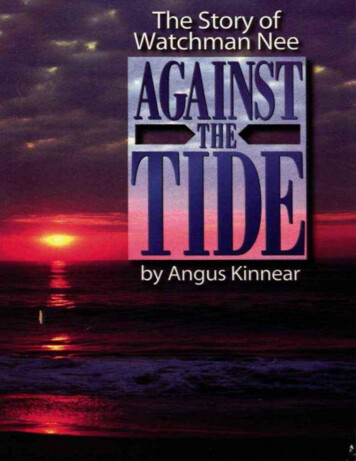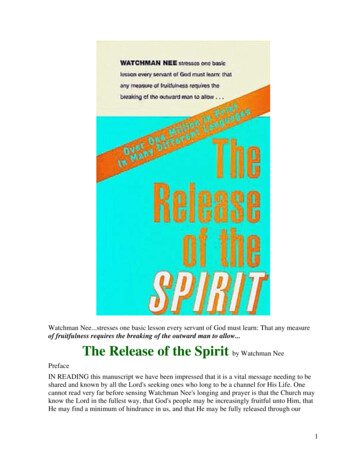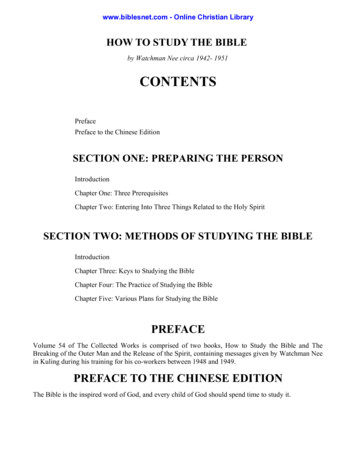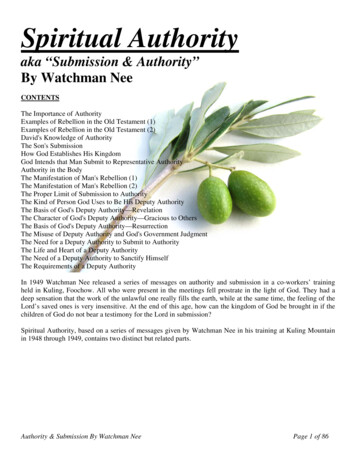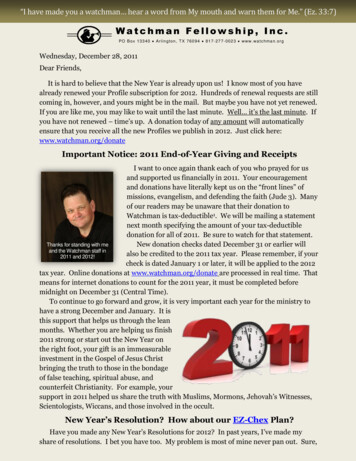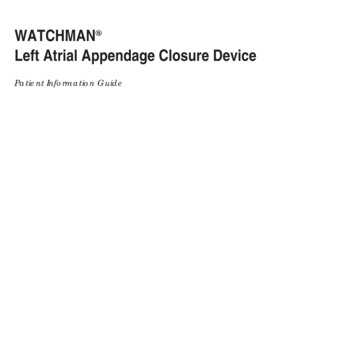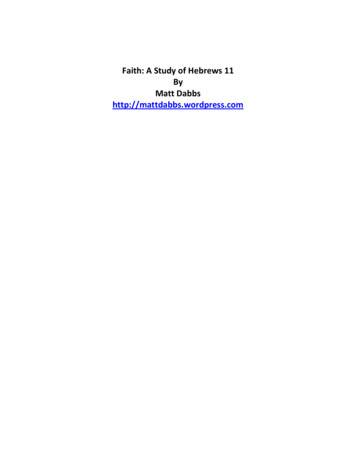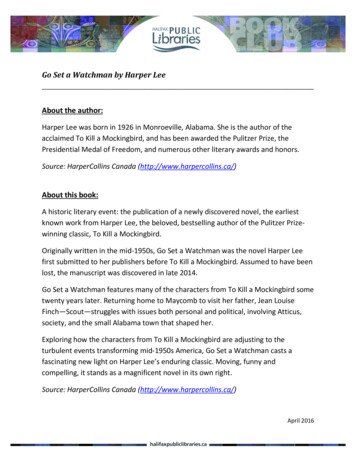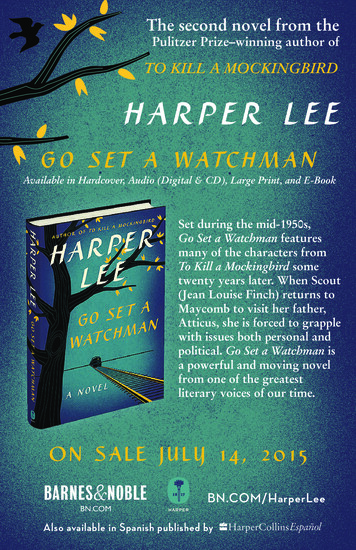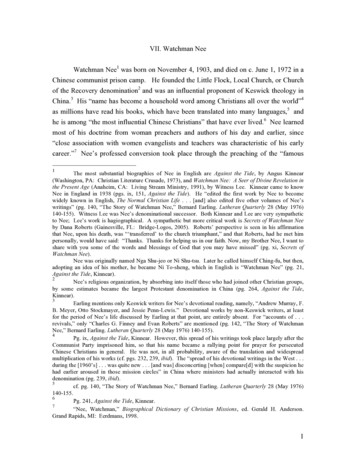
Transcription
VII. Watchman NeeWatchman Nee1 was born on November 4, 1903, and died on c. June 1, 1972 in aChinese communist prison camp. He founded the Little Flock, Local Church, or Churchof the Recovery denomination2 and was an influential proponent of Keswick theology inChina.3 His “name has become a household word among Christians all over the world”4as millions have read his books, which have been translated into many languages,5 andhe is among “the most influential Chinese Christians” that have ever lived.6 Nee learnedmost of his doctrine from woman preachers and authors of his day and earlier, since“close association with women evangelists and teachers was characteristic of his earlycareer.”7 Nee’s professed conversion took place through the preaching of the “famous1The most substantial biographies of Nee in English are Against the Tide, by Angus Kinnear(Washington, PA: Christian Literature Crusade, 1973), and Watchman Nee: A Seer of Divine Revelation inthe Present Age (Anaheim, CA: Living Stream Ministry, 1991), by Witness Lee. Kinnear came to knowNee in England in 1938 (pgs. ix, 151, Against the Tide). He “edited the first work by Nee to becomewidely known in English, The Normal Christian Life . . . [and] also edited five other volumes of Nee’swritings” (pg. 140, “The Story of Watchman Nee,” Bernard Earling. Lutheran Quarterly 28 (May 1976)140-155). Witness Lee was Nee’s denominational successor. Both Kinnear and Lee are very sympatheticto Nee; Lee’s work is hagiographical. A sympathetic but more critical work is Secrets of Watchman Neeby Dana Roberts (Gainesville, FL: Bridge-Logos, 2005). Roberts’ perspective is seen in his affirmationthat Nee, upon his death, was “‘transferred’ to the church triumphant,” and that Roberts, had he met himpersonally, would have said: “Thanks. Thanks for helping us in our faith. Now, my Brother Nee, I want toshare with you some of the words and blessings of God that you may have missed” (pg. xi, Secrets ofWatchman Nee).Nee was originally named Nga Shu-jeo or Ni Shu-tsu. Later he called himself Ching-fu, but then,adopting an idea of his mother, he became Ni To-sheng, which in English is “Watchman Nee” (pg. 21,Against the Tide, Kinnear).2Nee’s religious organization, by absorbing into itself those who had joined other Christian groups,by some estimates became the largest Protestant denomination in China (pg. 264, Against the Tide,Kinnear).3Earling mentions only Keswick writers for Nee’s devotional reading, namely, “Andrew Murray, F.B. Meyer, Otto Stockmayer, and Jessie Penn-Lewis.” Devotional works by non-Keswick writers, at leastfor the period of Nee’s life discussed by Earling at that point, are entirely absent. For “accounts of . . .revivals,” only “Charles G. Finney and Evan Roberts” are mentioned (pg. 142, “The Story of WatchmanNee,” Bernard Earling. Lutheran Quarterly 28 (May 1976) 140-155).4Pg. ix, Against the Tide, Kinnear. However, this spread of his writings took place largely after theCommunist Party imprisoned him, so that his name became a rallying point for prayer for persecutedChinese Christians in general. He was not, in all probability, aware of the translation and widespreadmultiplication of his works (cf. pgs. 232, 239, ibid). The “spread of his devotional writings in the West . . .during the [1960’s] . . . was quite new . . . [and was] disconcerting [when] compare[d] with the suspicion hehad earlier aroused in those mission circles” in China where ministers had actually interacted with hisdenomination (pg. 239, ibid).5cf. pg. 140, “The Story of Watchman Nee,” Bernard Earling. Lutheran Quarterly 28 (May 1976)140-155.6Pg. 241, Against the Tide, Kinnear.7“Nee, Watchman,” Biographical Dictionary of Christian Missions, ed. Gerald H. Anderson.Grand Rapids, MI: Eerdmans, 1998.1
woman evangelist . . . Dora Yu,”8 after Miss Yu’s preaching in the Methodist Tien-AnChapel had led Nee’s mother, Nee Ho-P’ing, to conviction of sin about her failure inparenting him in a particular area. Nee’s mother went on to become “a well-knownMethodist preacher, whose speaking tours included her native China” and abroad;9 Nee’swife was the daughter of a Chinese Christian and Missionary Alliance pastor. Neepublicly proclaimed his profession of Christianity at one of Miss Yu’s services by goingforward at the invitation. He then “longed to be trained by Dora Yu in Shanghai. Hismother agreed, and Dora Yu accepted him into her Bible school,”10 since Miss Yu notonly “traveled widely among missions in northern China and Korea” but, as a Methodistminister, had “establish[ed] her own Bible seminary in Shanghai.”11 He consequentlyattended the Bible school led by Miss Yu in Shanghai in 1920-21, although he wasexpelled because of disobedience to the school’s discipline. At Miss Yu’s suggestion, hethen went to Miss Margaret E. Barber. She, along with Miss L. S. Ballord and theChinese woman preacher Li Ai-ming, had a center where they preached to men andwomen and taught and prepared Chinese natives for church leadership.12 Nee therelearned Keswick theology and was influenced by the literature of the Welsh holinessrevival, writing to and reading the writings of Jessie Penn-Lewis13 and the Overcomermagazine which she edited, and through which Nee became familiar with RomanCatholic mystical quietists such as Madame Guyon, who “deeply influenced” and“greatly moved” Nee and “was to have a strong influence on his future thinking.”14 “Themystical leanings in . . . Lee [and] Nee . . . are traceable to . . . teachers such as JessiePenn-Lewis . . . and Madame Guyon.”15 Keswick and mystical influences such as thesewere the more important in light of Nee’s “self-imposed limitation [on] formal studies.”16Nee “testified publicly that he had learned many important spiritual truths from theOvercomer Movement via Jessie Penn-Lewis’s teachings. . . . Miss Barber . . . took back8Pgs. 11-16, 94, Watchman Nee: A Seer of the Divine Revelation, Lee; pgs. 28, 41-48, Against theTide, Kinnear.9Pg. 9, Understanding Watchman Nee, Dana Roberts; pgs. 52, 83, Against the Tide, Kinnear.10Pg. 15, Watchman Nee: A Seer of the Divine Revelation, Lee.11Pg. 41, Against the Tide, Kinnear.12Pg. 50, Against the Tide, Kinnear.13Pg. 65, Against the Tide, Kinnear.14“Watchman Nee (1903-1972): A Biographical Study,” by Huelon Mountfort. Elec. biographical-study; pgs. 62, 242, Against the Tide,Kinnear.15Pg. 13, “We Were Wrong: A Reassessment of the ‘Local Church’ Movement of Watchman Neeand Witness Lee,’” Christian Research Journal 32:06 (2009).16Pg. 156, Against the Tide, Kinnear.2
to China Jessie’s permission to publish the most useful Overcomer essays. The work wasundertaken by Watchman Nee, who printed them in his Rising Again magazine, andexpounded them and presented their essential teachings in his later books.”17 Indeed,“the format of . . . [the] four different Christian magazines . . . Nee edited . . . was by andlarge modeled after Jessie Penn-Lewis’s The Overcomer and T. Austin Sparks’s AWitness and A Testimony.”18 Nee quoted Penn-Lewis with some frequency;19 indeed,“The Spiritual Man was based mainly upon the writings and experience of Evan Robertsand Jessie Penn-Lewis,” whose works Nee had devoured when he wrote The SpiritualMan at the age of twenty-four,20 although Madame Guyon was also influential.21 Nee’sbook, rejecting sola Scriptura for truth based on both “the Word and experience,”22 leansheavily upon Penn-Lewis and Roberts23 for its views on spiritual warfare and othertopics,24 as he “delved into . . . Jessie Penn-Lewis on the questions of soul and spirit andof triumph over Satanic power.”25 The book Nee’s “Little Flock” denomination was thusbirthed in connection with the ministry of Miss Barber, her students, and theologylearned from other women.26 Nee continued to seek Miss Barber’s advice and counseluntil shortly before her death in 1930, and he acknowledged her as a powerful influencein his own life. Her affection for him was evident in her leaving him her most prizedpossession, her Bible.27 “No single person is more responsible for the development of17Pg. 240-243, The Trials and Triumphs of Mrs. Jessie Penn-Lewis, Brynmor Pierce Jones.Pgs. 53-54, Secrets of Watchman Nee, Dana Roberts. Sparks himself was influenced by PennLewis (pg. 105, Against the Tide, Kinnear).19For examples, see The Spiritual Man, Watchman Nee, comb. ed., pgs. 588, 589, 601, 609, 610,630, etc.20Pgs. 102-103, Against the Tide, Kinnear. It is noteworthy that The Spiritual Man was “the firstand last book [Nee] ever sat down and wrote, the rest of his publications all being transcriptions of hispreaching and teaching,” and that Nee also thought his book “will not be reprinted,” a view he affirmed atvarious times to his coworkers (pgs. 103, 251-252, ibid.).21Pg. 149, “The Story of Watchman Nee,” Bernard Earling. Lutheran Quarterly 28 (May 1976) 140155. A few other Keswick writers are also mentioned.22Pg. 149, “The Story of Watchman Nee,” Bernard Earling. Lutheran Quarterly 28 (May 1976) 140155. “[E]very point of” The Spiritual Man could “be experimentally proven,” even if it could not beproven from the Bible (pg. 149, ibid; cf. The Spiritual Man 1:7-20).23Evan Roberts himself was profoundly influenced by Jessie Penn-Lewis.24Pg. 255, Watchman Nee: A Seer of the Divine Revelation, Lee.25Pg. 86, Against the Tide, Kinnear.26Interestingly, by the 1940s Nee’s “spiritual emphasis . . . catered . . . to a taste among thededicated women missionaries who had rejoined him from the West and who . . . constituted a growingbody of foreign sympathizers. Some . . . resigned from their missions to attach themselves to Nee’s work . . [certain] ladies were unquestionably carried away with adulation of Nee as . . . the only person in Chinathrough whom they might discover God’s will” (pgs. 161-162, Against the Tide, Kinnear).27Pg. 113, Against the Tide, Kinnear.183
Nee’s theology than Miss Barber.”28 “[T]he main influences upon [Nee were] so often . . women—Dora Yu, his mother, Margaret Barber, Ruth Lee, [and] ElizabethFischbacher[.]”29 In summary:Whenever [Nee] had a problem or needed spiritual instruction or strengthening, he would go to . . .Margaret E. Barber . . . an Anglican missionary[.] . . . [He testified that] [e]very Saturday [he]went to Ma-Kiang, Fukien, to listen to Miss Margaret Barber’s preaching. . . . [H]e said that hescarcely found one person in the Western world who could compare with Margaret Barber. It wasthrough this sister that he obtained the foundation of the spiritual life. He frequently told othersthat it was through a sister [Dora Yu] that he was saved and that it was also through a sister[Margaret Barber] that he was edified. . . . Through Margaret Barber he became familiar with thebooks of [writers such as] Jessie Penn-Lewis . . . [who taught him about] the subjective aspect ofChrist’s death[,] . . . spiritual warfare[,] . . . [and] the three parts of man. . . . Watchman Neereceived a clear vision of what it means to be an overcomer by . . . reading the writings of JessiePenn-Lewis. . . . Madame Guyon’s biography . . . and the writings of other mystics helped him inthe matter of life. . . . Mary McDonough’s book . . . was a great help . . . [c]oncerning God’s planof redemption.30Under the influence of his mother and with the assistance of Miss Barber and Dora Yu,Nee rejected infant baptism for believer’s immersion.31 He consequently sought out MissBarber to be baptized, receiving a heavenly sign at the time of the ceremony thatindicated the smile of supernatural power upon these proceedings.32 Nee learned hisevangelistic practices from “Miss Groves[,] Margaret Barber’s co-worker.”33 Womentaught Nee his doctrines of Spirit filling, applying the blood of Christ, living withoutfinancial support, crucifixion with Christ, overcoming, spiritual life, and many of hisother distinctive beliefs.34 “Four sisters were vital to Watchman Nee in his life and work.He was saved through the preaching of Dora Yu, perfected under Margaret Barber, andsustained by two elderly co-workers, Ruth Lee and Peace Wang,”35 who were themselvesimportant woman preachers.36 Nee accepted the unscriptural37 ministry of the woman28Pg. 15, Secrets of Watchman Nee, Roberts.Pg. 156, Against the Tide, Kinnear.30Pgs. 11-18, 25-26, 70, 81, Watchman Nee: A Seer of the Divine Revelation, Lee.31Pg. 36, Watchman Nee: A Seer of the Divine Revelation, Lee.32Pgs. 54-55, Against the Tide, Kinnear.33Pg. 45, Watchman Nee: A Seer of the Divine Revelation, Lee.34See pgs. 45-46, 55-56, 59-60, 69-70, 73, 75, 81, 85, 127, 138, 141, 143, 148, 310-311, etc.,Watchman Nee: A Seer of the Divine Revelation, Lee.35Pg. 101, Watchman Nee: A Seer of the Divine Revelation, Lee.36Ruth Lee’s “fiery preaching” to men and women influenced many, and her one-time pupil, PeaceWang, was also an “independent evangelist.” (pgs. 57, 101-102, Against the Tide, Kinnear). After Nee’scoming to a conviction that was less than favorable to such matters, “the existence of gifted womenpreachers seems to have created a problem.” One attempt at a solution took place in a “Canonton meeting[where] . . . men suspend[ed] a large white sheet across the width of the hall. . . . Ruth Lee and Peace Wangwere visiting the local church. Since they must not preach to men, the brothers would therefore sit behindthe sheet and listen to their messages from there!” (pg. 179, Against the Tide, Kinnear.).371 Corinthians 14:34-37; 1 Timothy 2:11-15.294
evangelist Ruth Lee because of a dream, 38 and she became the acting editor ofnewsletters, papers, and books that Nee’s denomination put out.39 She also edited andprepared for the press works by Nee such as his The Spiritual Man, composed under RuthLee’s “literary tutelage.”40 As Nee’s new denomination was being born, the ordinance ofcommunion was celebrated for the first time in Peace Wang’s home with Wang, Nee,Ruth Lee, and one other person present. 41 Witness Lee also ascribed the greatestinfluence upon his life, after Nee, to Peace Wang, the woman minister whose “preachingwas so convincing and prevailing that many denominations invited her to holdmeetings.”42 Although Nee eventually came to a position that did not endorse womenpreachers of this sort,43 he continued to believe that women should sometimes lead thecongregation in prayer in prayer meetings.44 Nee translated works by Jessie Penn-Lewisinto Chinese, and had his co-workers translate works by Madame Guyon, Mrs. C. A.McDonough and Mrs. C. E. Cowman.45 In particular, Miss Barber not only “tutored Neein the Keswick approach to spiritual dynamics, [but also] assuredly taught him a partialrapture theory,”46 since Miss Barber was sent out as an independent missionary fromSurry Chapel, Norwich, England, where the founder of the partial Rapture theory, RobertGovett (1813-1901),47 was the minister. Nee admits that his exposition of the book ofRevelation, Come Lord Jesus, is dependent upon Govett’s The Apocalypse Expounded(1920).48 Nee was teaching the partial Rapture error by at least 1924, confirmed not only3839Pgs. 103-104, Watchman Nee: A Seer of the Divine Revelation, Lee.Pg. 300, Watchman Nee: A Seer of the Divine Revelation, Lee; pg. 148, Against the Tide,Kinnear.40Pgs. 98-99, 101, 210, 262-263, Against the Tide, Kinnear.Pg. 102, Against the Tide, Kinnear.42Pgs. 109-110, 113 Watchman Nee: A Seer of the Divine Revelation, Lee.43Pgs. 104-105, Against the Tide, Kinnear.44Pg. 179, Watchman Nee: A Seer of the Divine Revelation, Lee.45Pgs. 261-262, Watchman Nee: A Seer of the Divine Revelation, Lee.46Pg. 162, Secrets of Watchman Nee, by Dana Roberts.47“The modern theory of partial rapture seems to have originated in the writings of Robert Govettwho published a book setting forth the theory as early as 1853. In this work he expounds his view thatparticipation in the kingdom is conditional and depends upon worthy conduct. . . . Others have made asignificant contribution to the propagation of the theory. D. M. Panton, as editor of The Dawn (London),uses his publication to promote this teaching. Such writers as Ira E. David, Sarah Foulkes Moore, WilliamLeask, and C. G. A. Gibson-Smith contribute to The Dawn articles in support of this theory. For the mostpart, however, the view is limited to a few adherents who are generally treated as heterodox by otherpretribulationists” (pgs. 193-194, “Premillennialism and the Tribulation, Part V: Partial Rapture Theory,”John F. Walvoord. Bibliotheca Sacra 112:447 (Jul 55) 193-209).48“This study [Come, Lord Jesus] was given by Mr. Watchman Nee in the early years of hisministry. . . . In the study of prophecy our brother followed the approach of such people as G. H. Pember,Robert Govett and D. M. Panton[.]” (“Translator’s Preface,” in Come Lord Jesus: A Study of the Book ofRevelation, Watchman Nee. New York, NY: Christian Fellowship Publishers, 1976). “Robert Govett, D.415
by Miss Barber, but also by the Overcomer literature of Jessie Penn-Lewis and EvanRoberts.49 He wrote:There is evidence in the Bible to show that . . . believers will be Raptured after the Tribulation,[but] that does not mean that all believers will be Raptured after the Tribulation . . . some will beRaptured before the Tribulation. . . . [O]nly a small number (one-seventh) can be raptured beforethe tribulation[.] . . . [N]ot all, but only a portion, of the church will be raptured before thetribulation. . . . Not all those who are regenerated can be raptured. One must pray always. . . .Some believers will be raptured before the tribulation, and another group of believers will remainuntil after the tribulation. The latter will suffer the trial of the tribulation.50In 1935 Nee became involved with Pentecostalism through Miss Elizabeth Fischbacherof the China Inland Mission. 51 He had “overcome his reservations about womenpreachers sufficiently to attend her meetings,” and, in line with his Keswickcontinuationism, “acknowledged the Holy Spirit’s . . . gifts to the church of healing andof speaking with and interpretation of tongues.” 52 Nee “found peace and spiritualblessing in her message and some experiences associated with her Pentecostaltheology.”53 Miss Fischbacher, who translated various items for the Little Flock intoEnglish,54 accompanied Nee to the 1938 Keswick convention;55 the addresses in Nee’sM. Panton, and G. H. Pember . . . [a]ll . . . hold to a ‘selective rapture’ position, that only the faithfulbeliever will be resurrected or raptured to enter the millennial kingdom” (pg. 77, Journal of the GraceEvangelical Society 1:1 (Autumn 1988)). Nee thus clearly leaned upon earlier partial-Rapturists, although,of course, he also added in his own ideas to the doctrinal mix.49Thus, Nee spoke of the “rapture of the overcomers,” who in his mind were only an elite subset ofall believers, already in his preaching in that year (pgs. 34 & preface, The Latent Power of the Soul, Nee).See also pgs. 199-200, Watchman Nee: A Seer of the Divine Revelation, Lee; cf. pg. 83, God’s Plan andthe Overcomers, Nee, as an example of the partial Rapture theology Nee held in 1934 (preface, ibid). Seealso “Rapture,” by Watchman Nee, elec. acc. http://www3.telus.net/trbrooks/Partial rapture.htm.50Chapter 25, Study on Matthew, in The Collected Works of Watchman Nee, Set 1 Vol. 15,Watchman Nee. Anaheim, CA: Living Stream Ministry, n. d. ISBN: 0-87083-589-0. Part of the abovequotation is the title to the chapter; capitalization has been changed for that portion of the quotation. Seealso “Rapture,” by Watchman Nee, elec. acc. http://www3.telus.net/trbrooks/Partial rapture.htm.51In light of the heavy Keswick influence (pg. 85, The Keswick Story: The Authorized History of theKeswick Convention, Polluck) and the interdenominationalism of Hudson Taylor’s China Inland Mission, itis not surprising that Pentecostalism permeated the organization almost immediately after the inception ofthe tongues movement. Cecil Polhill, one of the “Cambridge Seven,” is a clear example. In 1909, he waselected president of the Pentecostal Missionary Union, a position he retained until the Union merged withthe Assemblies of God in 1925. “Mr. Polhill had visited the [Pentecostal] outpouring of the Spirit at LosAngeles, and had received the baptism of the Holy Ghost with signs following . . . there. He quicklybecame friendly with Alexander Boddy, and for the first ten years of the Pentecostal Movement in theBritish Isles these two men were the most outstanding figures.” At the same time, already before 1909Polhill was on the Council of the China Inland Mission, a leadership position he held until his death in1938. The fact he could lead both the China Inland Mission and the Pentecostal Missionary Union clearlyillustrates the openness of the CIM to the charismatic movement (pgs. 46-49; The Pentecostal Movement,Donald Gee; pgs. 252-253, The Making of the Modern Church, Worrall).52Pg. 145, “The Story of Watchman Nee,” Bernard Earling. Lutheran Quarterly 28 (May 1976) 140155.53Pg. 25, Secrets of Watchman Nee.54Cf. pgs. 137, 152-154, 254, Against the Tide, Kinnear; Nee’s book Rethinking the Work wastranslated by her, as an example.6
The Normal Christian Life were delivered on this trip to the West.56 On this trip Neetaught, after the manner of Pentecostalism, that “we must expect God to seal His Wordwith signs and wonders” such as “the gift of healing” and exorcism—indeed, Christianswho do “not know how to cast out demons . . . avail . . .nothing,” Nee proclaimed.57Watchman Nee was warmly received at Keswick, so that his leading the Convention inprayer was considered “the crowning moment of vision” for those present,58 although atvarious periods up to this time sundry Chinese missionaries had rather bluntly declaredthat Nee was “a devil and a deceiver of many.”59 Nee was not only already publiclypromulgating the continuation of the Apostolic sign gifts, but also such errors asopposition to the classical doctrine of the Trinity and a rejection of the eternal generationof the Son of God.60 Into later periods Nee continued to be assaulted for “seriouserror.”61 Miss Fischbacher also recorded and translated into English Nee’s messages,62 asshe made “gifted versions and transcriptions . . . of the best of his preaching andwriting.” 63 Moved by women preachers, Nee adopted his partial Rapture and pro55Pgs. 148-149, Against the Tide, Kinnear.Pgs. 151-152, Against the Tide, Kinnear. The title of Nee’s book echoes the teaching of Robert P.Smith at the Oxford Convention: “The Higher Christian Life . . . [which] so few were living . . . should becalled . . . the only normal Christian life” (pg. 54, Account of the Union Meeting for the Promotion ofScriptural Holiness, Held at Oxford, August 29 to September 7, 1874. Chicago: Revell, 1874). Mr.Smith’s terminology of Higher Life victory as the “normal Christian life” became common in Keswickcircles and was adopted by Nee.57Pgs. 178-182, What Shall This Man Do? Watchman Nee. Fort Washington, PA: ChristianLiterature Crusade, 1973. Italics in original.58Pg. 256, Transforming Keswick: The Keswick Convention, Past, Present, and Future, Price &Randall.59Pg. 74, Against the Tide, Kinnear.60Thus, in 1934 Nee could teach: “From eternity past up to the resurrection the Lord is the onlybegotten Son. . . . before death He is the only begotten Son.” Thus, Nee was already teaching that JesusChrist was not the only begotten Son of God after His resurrection—“after He is raised from the dead Hebecomes the firstborn Son” (pg. 12, 24, God’s Plan and the Overcomers, Nee), an error that is related toNee’s modalistic affirmation that the Son became the Holy Spirit after the resurrection. Watchman Nee byno means would agree with classical Trinitarianism as set forth in Nicaeno-Constantinopolitan,Chalcedonian, or Athanasian creeds, nor with a statement such as The London Baptist Confession of Faithof 1689: “The Lord our God is but one only living and true God . . . in this divine and infinite Being thereare three subsistences, the Father, the Word (or Son), and the Holy Spirit, of one substance, power, andeternity, each having the whole divine essence, yet the essence undivided: the Father is of none, neitherbegotten nor proceeding; the Son is eternally begotten of the Father; the Holy Spirit proceeding from theFather and the Son; all infinite, without beginning, therefore but one God, who is not to be divided innature and being, but distinguished by several peculiar relative properties and personal relations; whichdoctrine of the Trinity is the foundation of all our communion with God, and comfortable dependence onHim” (2:1, 3).61Pg. 164, Against the Tide, Kinnear.62Pg. 54, Secrets of Watchman Nee.63Pg. xii, Against the Tide, Kinnear.567
Pentecostal errors, as well as errors on sanctification, other corruptions of soteriology,and further false doctrines. Nevertheless, Keswick welcomed him with open arms.While Nee’s doctrine and practice were most heavily influenced by womenpreachers and teachers, he also, naturally, was influenced by some men. For example,Nee had compositions translated into Chinese of the Roman Catholic mystic Fenélon, theCatholic Carmelite hermit and mystic Brother Lawrence, and partial-Rapture promulgatorRobert Govett.64 He “read . . . all he could of Charles G. Finney, and of Evan Robertsand the Welsh spiritual awakening of 1904-5.”65 Nee was also influenced by men such asAndrew Murray and F. B. Meyer, as well as John Darby and various other writers amongthe Plymouth Brethren, particularly a group of Brethren writers that held to seriousChristological heresies.66 He did not sit at the feet of women alone to learn his distinctiveerrors.64Pg. 261, Watchman Nee: A Seer of the Divine Revelation.Pg. 85, Against the Tide, Kinnear.66A group known as the London Brethren, who were Exclusive, as opposed to the Open Brethren,invited Nee to England in 1933. Watchman Nee was “fully accredited as in fellowship” with them (pgs.216-217, The Recovery and Maintenance of the Truth, A. J. Gardiner. Kingston on Thames, England:Stow Hill Bible and Tract Depot, 1951). Nee was happy to fellowship with them despite the fact that theybelieved in severe errors on the nature of God and Christ. The London Brethren denied the eternal Sonshipof Christ: “When the Son of God is mentioned in Scripture . . . it . . . is . . . always in manhood . . . there is. . . not . . . eternal sonship . . . in Scripture . . . His sonship [is spoken of] only after He is said to havebecome flesh . . . it is only as having become incarnate that the Lord is spoken of as Son” (pgs. 202-206,ibid; italics in original). They rejected Biblical and Chalcedonian Christology; Christ as “‘perfect God andperfect Man’ is not scripture . . . [it] is derogatory and dishonoring the Son . . . [it is] contrary to theteaching of Scripture . . . [to affirm that] the truth of His Person consists in the union in Him of God andman” (pgs. 139, 145-146 ibid). Affirmations that smacked of modalism were also made: “[A]ll thePersons of the Trinity were expressed by the Man Christ Jesus” (pg. 145, ibid). Errors in soteriology werealso held, such as that one does not receive eternal life as soon as one is born again, but only upon beingsealed by the Spirit: “A man is born again, is enlightened by the gospel and is then sealed by the Spirit, andit is then that by the Spirit he enters into eternal life” (pg. 132, ibid). Nonetheless, Nee was happy to beinfluenced by these men and take the Lord’s Supper with them, carry on correspondence with them fromChina to learn of them, receive visits from them to China, and visit England to fellowship with and learnfrom them (pg. 216ff., ibid).However, fellowship between Nee and the London Brethren was eventually broken—not becauseNee rejected their heresies, but because Nee held to false doctrines beyond those which the Brethrensupported. Nee was willing to take the Lord’s Supper with advocates of the partial Rapture error and heldto it himself (pg. 217, 221, ibid). Nee taught: “We must distinguish between ‘sins’ (either morally ordoctrinally) that hinder fellowship with God, and ‘sins’ which do not,” to which the London Brethrenproperly replied: “To suggest, as yo[u] . . . d[o], that there are sins which do not hinder, as you put it,‘fellowship with God,’ is an affront to His holiness. Not only are the expressions you use in thisconnection quite unscriptural, but they disclose grave ignorance of the truth as to the presence and serviceof the Holy Spirit” (pgs. 218, 220, ibid.). Furthermore, the Brethren affirmed: “[Y]ou prefer to substitutefor the plain teaching of Scripture, your own professed experimental knowledge” (pgs. 220-221, ibid).Both the London Brethren and Watchman Nee were fine with severe errors on the doctrine of God andChrist, but the Brethren were not willing to join Nee in advocating a partial Rapture, open communion, sinsthat “do not hinder fellowship with God,” and replacement of sola Scriptura for a priority upon mysticalexperience.658
Nee taught, following Jessie Penn-Lewis, that only the human spirit isregenerated, and many have been influenced towards this error by his writings. Neewrote:After Adam fell, his spirit became dead. . . . The death of Adam began from his spirit. . . . Thedeath in the spirit of the first man gradually spread to the realm of the body. . . . It continued towork in him until his spirit, soul, and body all became dead. . . . From that time on the spirit ofAdam (as well as that of all his descendants) was suppressed by the soul. Soon after, through thesoul’s suppression, the spirit was merged into the soul, and the two parts became closely knittogether. . . . Since the spirit became so closely knit to the soul, man began . . . to act according tohis intellect or his feelings. At that time, the spirit had lost all its power and senses, and hadbecome dormant . . . [that is, it had] fallen unconscious. Al
VII. Watchman Nee Watchman Nee1 was born on November 4, 1903, and died on c. June 1, 1972 in a Chinese communist prison camp. He founded the Little Flock, Local Church, or Church of the Recovery denomination2 and was an influential proponent of Keswick theology in China.3 His "name has become a household word among Christians all over the .
